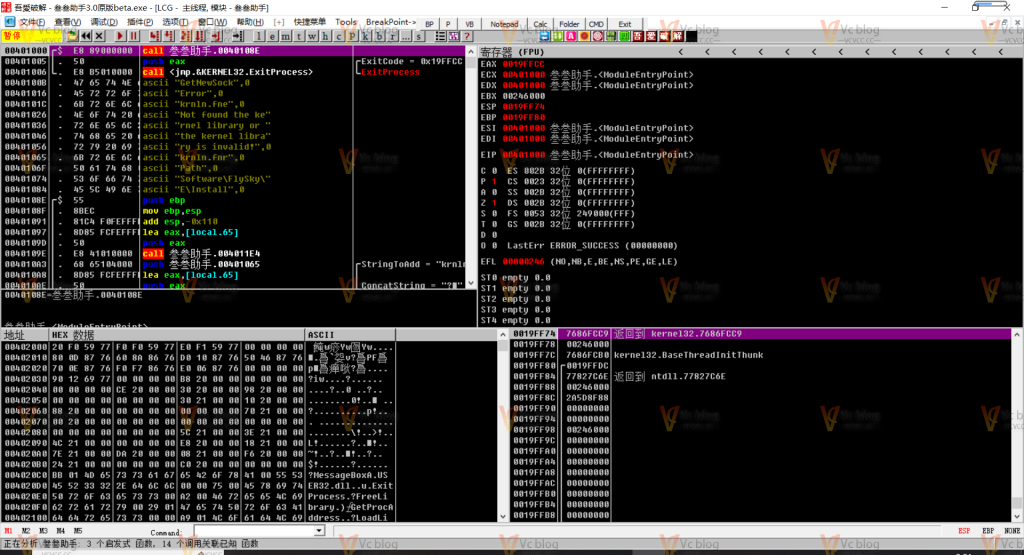本文针对JavaScript原型继承中的核心痛点问题,通过构建真实的继承场景,深度分析原型链断裂、constructor属性丢失、方法覆盖冲突、多重继承困境等高频问题。提供从ES5原型继承到ES6类继承的完整迁移方案,以及生产环境中的最佳实践和调试方法。
![图片[1]-JavaScript原型链继承陷阱:从constructor丢失到多重继承解决方案](https://blogimg.vcvcc.cc/2025/11/20251109135317816-1024x576.png?imageView2/0/format/webp/q/75)
一、原型链基础与constructor属性丢失
1. 原型链继承的基本问题
理解原型链继承中的constructor属性问题:
// 原型继承中的constructor丢失问题
class PrototypeChainIssues {
static demonstrateConstructorProblem() {
console.log('=== 原型链constructor问题 ===');
// 基础构造函数
function Animal(name) {
this.name = name;
this.energy = 100;
}
Animal.prototype.eat = function() {
this.energy += 10;
console.log(`${this.name}吃东西,能量: ${this.energy}`);
};
// 错误的继承方式 - 直接修改原型链
function Dog(name, breed) {
Animal.call(this, name);
this.breed = breed;
}
// 问题1: 直接设置prototype会导致constructor丢失
Dog.prototype = Animal.prototype; // 错误做法
// 验证问题
const dog1 = new Dog('Buddy', 'Golden Retriever');
console.log('dog1.constructor:', dog1.constructor); // 输出: [Function: Animal]
console.log('dog1 instanceof Dog:', dog1 instanceof Dog); // true
console.log('dog1 instanceof Animal:', dog1 instanceof Animal); // true
// 问题2: 原型污染
Dog.prototype.bark = function() {
console.log(`${this.name}在叫!`);
};
// 意外地给Animal也添加了bark方法
const animal = new Animal('Generic Animal');
// animal.bark(); // 这会工作,但不应该!
}
// 正确的原型继承方式
static properPrototypeInheritance() {
console.log('\n=== 正确的原型继承 ===');
function Animal(name) {
this.name = name;
this.energy = 100;
}
Animal.prototype.eat = function() {
this.energy += 10;
console.log(`${this.name}吃东西,能量: ${this.energy}`);
};
function Dog(name, breed) {
Animal.call(this, name); // 调用父类构造函数
this.breed = breed;
}
// 正确方式1: 使用Object.create
Dog.prototype = Object.create(Animal.prototype);
// 恢复constructor属性
Dog.prototype.constructor = Dog;
// 添加子类方法
Dog.prototype.bark = function() {
console.log(`${this.name}在叫!`);
};
// 验证
const dog = new Dog('Max', 'Labrador');
console.log('dog.constructor:', dog.constructor); // [Function: Dog]
console.log('dog instanceof Dog:', dog instanceof Dog); // true
console.log('dog instanceof Animal:', dog instanceof Animal); // true
dog.eat(); // 继承的方法
dog.bark(); // 自己的方法
// 检查原型污染
const animal = new Animal('Generic');
console.log('animal有bark方法吗?', 'bark' in animal); // false
}
// 继承工具函数
static createInheritanceHelper() {
return {
// 标准的继承函数
inherit: function(Child, Parent) {
// 创建原型链
Child.prototype = Object.create(Parent.prototype);
// 恢复constructor
Child.prototype.constructor = Child;
// 添加superclass引用(可选)
Child.superclass = Parent.prototype;
},
// 检查继承链
checkInheritance: function(instance, Constructor) {
let current = instance;
const chain = [];
while (current) {
chain.push(current.constructor.name);
current = Object.getPrototypeOf(current);
// 避免无限循环
if (!current || current === Object.prototype) break;
}
console.log('原型链:', chain.join(' -> '));
return instance instanceof Constructor;
},
// 深度继承检查
deepInstanceOf: function(obj, constructor) {
if (obj instanceof constructor) return true;
let proto = Object.getPrototypeOf(obj);
while (proto) {
if (proto.constructor === constructor) return true;
proto = Object.getPrototypeOf(proto);
}
return false;
}
};
}
}
// 运行原型链示例
PrototypeChainIssues.demonstrateConstructorProblem();
PrototypeChainIssues.properPrototypeInheritance();2. 原型方法覆盖与super调用
理解原型方法覆盖和模拟super调用:
// 方法覆盖与super调用模拟
class MethodOverrideSolutions {
static demonstrateMethodOverride() {
console.log('=== 方法覆盖问题 ===');
function Vehicle(speed) {
this.speed = speed;
}
Vehicle.prototype.move = function() {
console.log(`以 ${this.speed}km/h 速度移动`);
return this.speed;
};
function Car(speed, fuel) {
Vehicle.call(this, speed);
this.fuel = fuel;
}
// 设置继承
Car.prototype = Object.create(Vehicle.prototype);
Car.prototype.constructor = Car;
// 问题:直接覆盖父类方法,无法调用父类实现
Car.prototype.move = function() {
console.log(`汽车使用${this.fuel}燃料移动`);
// 这里想调用父类的move方法,但丢失了访问方式
// 我们需要模拟super调用
};
// 解决方案1: 保存父类方法引用
Car.prototype.parentMove = Vehicle.prototype.move;
Car.prototype.move = function() {
console.log(`汽车使用${this.fuel}燃料移动`);
// 调用父类方法
const speed = this.parentMove.call(this);
console.log(`实际速度: ${speed}km/h`);
return speed;
};
const car = new Car(60, '汽油');
car.move();
}
// 更优雅的super调用方案
static createSuperPattern() {
console.log('\n=== 优雅的super调用方案 ===');
function Vehicle(speed) {
this.speed = speed;
}
Vehicle.prototype.move = function() {
console.log(`Vehicle: 以 ${this.speed}km/h 速度移动`);
return this.speed;
};
function Car(speed, fuel) {
Vehicle.call(this, speed);
this.fuel = fuel;
}
Car.prototype = Object.create(Vehicle.prototype);
Car.prototype.constructor = Car;
// 使用闭包保存父类方法
Car.prototype.move = (function() {
// 保存父类方法
const parentMove = Vehicle.prototype.move;
return function() {
console.log(`Car: 使用${this.fuel}燃料`);
// 调用父类方法
const result = parentMove.call(this);
console.log(`Car: 移动完成,速度${result}km/h`);
return result;
};
})();
const car = new Car(80, '柴油');
car.move();
}
// 通用的super工具函数
static createSuperHelper() {
return {
// 为构造函数添加super能力
enableSuper: function(Child, Parent) {
// 存储父类原型方法引用
Child.prototype._super = {};
// 遍历父类原型的所有方法
for (const methodName of Object.getOwnPropertyNames(Parent.prototype)) {
if (methodName !== 'constructor' && typeof Parent.prototype[methodName] === 'function') {
Child.prototype._super[methodName] = Parent.prototype[methodName];
}
}
},
// 动态super调用
callSuper: function(instance, methodName, ...args) {
if (instance._super && instance._super[methodName]) {
return instance._super[methodName].call(instance, ...args);
}
throw new Error(`父类方法 ${methodName} 不存在`);
}
};
}
}
// 使用方法覆盖示例
MethodOverrideSolutions.demonstrateMethodOverride();
MethodOverrideSolutions.createSuperPattern();
// 使用super工具
const superHelper = MethodOverrideSolutions.createSuperHelper();
function Animal(name) {
this.name = name;
}
Animal.prototype.speak = function() {
console.log(`${this.name}发出声音`);
};
function Dog(name, breed) {
Animal.call(this, name);
this.breed = breed;
}
Dog.prototype = Object.create(Animal.prototype);
Dog.prototype.constructor = Dog;
// 启用super支持
superHelper.enableSuper(Dog, Animal);
Dog.prototype.speak = function() {
console.log(`${this.name}(${this.breed})准备叫:`);
// 调用父类方法
superHelper.callSuper(this, 'speak');
console.log('汪汪!');
};
const dog = new Dog('Buddy', 'Golden');
dog.speak();二、ES6类继承与super关键字
1. ES6类继承的正确用法
理解ES6类继承的特性和陷阱:
// ES6类继承深度解析
class ES6ClassInheritance {
static demonstrateClassInheritance() {
console.log('=== ES6类继承 ===');
class Animal {
constructor(name) {
this.name = name;
this.energy = 100;
console.log(`Animal构造函数: ${name}`);
}
eat() {
this.energy += 10;
console.log(`${this.name}吃东西,能量: ${this.energy}`);
}
sleep() {
this.energy += 20;
console.log(`${this.name}睡觉,能量: ${this.energy}`);
}
}
class Dog extends Animal {
constructor(name, breed) {
// 必须首先调用super()
super(name); // 相当于 Animal.call(this, name)
this.breed = breed;
console.log(`Dog构造函数: ${name}, ${breed}`);
}
bark() {
console.log(`${this.name}在叫!`);
}
// 方法覆盖
eat() {
console.log(`${this.name}(${this.breed})准备吃东西...`);
// 使用super调用父类方法
super.eat();
console.log('吃完后摇尾巴');
}
}
// 使用示例
const dog = new Dog('Max', 'Husky');
dog.eat();
dog.bark();
dog.sleep();
// 检查继承关系
console.log('dog instanceof Dog:', dog instanceof Dog);
console.log('dog instanceof Animal:', dog instanceof Animal);
console.log('dog.constructor:', dog.constructor.name);
}
// ES6类继承的常见陷阱
static classInheritancePitfalls() {
console.log('\n=== ES6类继承陷阱 ===');
class Animal {
constructor(name) {
this.name = name;
}
}
class Dog extends Animal {
constructor(name, breed) {
// 陷阱1: 忘记调用super()
// 如果没有这行会报错: Must call super constructor...
super(name);
this.breed = breed;
}
}
// 陷阱2: 在super()之前访问this
class ProblematicDog extends Animal {
constructor(name, breed) {
// console.log(this); // 错误: 在super()之前不能使用this
super(name);
this.breed = breed;
}
}
// 陷阱3: 箭头函数和super
class Bird extends Animal {
constructor(name) {
super(name);
this.fly = () => {
// 箭头函数中的super指向定义时的上下文
console.log(`${this.name}在飞`);
// super.eat(); // 这不会工作,因为箭头函数没有自己的super
};
}
// 正确的方式
properFly() {
console.log(`${this.name}在飞`);
super.eat(); // 这可以工作
}
}
const dog = new Dog('Buddy', 'Golden');
const bird = new Bird('Tweety');
bird.fly();
bird.properFly();
}
// 静态属性和继承
static staticPropertiesInheritance() {
console.log('\n=== 静态属性继承 ===');
class Animal {
static className = 'Animal';
static describe() {
return `这是一个${this.className}类`;
}
constructor(name) {
this.name = name;
}
}
class Dog extends Animal {
static className = 'Dog'; // 覆盖静态属性
static describe() {
return `${super.describe()},专门用于狗`;
}
}
console.log('Animal类名:', Animal.className);
console.log('Dog类名:', Dog.className);
console.log('Animal描述:', Animal.describe());
console.log('Dog描述:', Dog.describe());
// 静态属性也被继承
console.log('Dog继承Animal的静态方法吗?', typeof Dog.describe === 'function');
}
// 私有字段和继承
static privateFieldsInheritance() {
console.log('\n=== 私有字段继承 ===');
class Animal {
#privateEnergy = 100; // 私有字段
constructor(name) {
this.name = name;
}
// 访问私有字段的方法
getEnergy() {
return this.#privateEnergy;
}
setEnergy(value) {
this.#privateEnergy = value;
}
}
class Dog extends Animal {
#privateBreed; // 子类的私有字段
constructor(name, breed) {
super(name);
this.#privateBreed = breed;
}
getBreed() {
return this.#privateBreed;
}
// 可以调用父类方法访问父类的私有字段
displayInfo() {
console.log(`${this.name}是${this.getBreed()},能量: ${this.getEnergy()}`);
}
}
const dog = new Dog('Max', 'Labrador');
dog.displayInfo();
// 私有字段无法直接访问
// console.log(dog.#privateEnergy); // 语法错误
// console.log(dog.#privateBreed); // 语法错误
}
}
// 运行ES6类继承示例
ES6ClassInheritance.demonstrateClassInheritance();
ES6ClassInheritance.classInheritancePitfalls();
ES6ClassInheritance.staticPropertiesInheritance();
ES6ClassInheritance.privateFieldsInheritance();2. 混入模式实现多重继承
JavaScript中实现多重继承的解决方案:
// 混入模式实现多重继承
class MultipleInheritanceSolutions {
// 基础混入函数
static createMixin(baseClass, ...mixins) {
return mixins.reduce((accumulated, currentMixin) => {
return currentMixin(accumulated);
}, baseClass);
}
// 属性复制混入
static copyPropertiesMixin() {
console.log('=== 属性复制混入 ===');
// 飞行能力混入
const Flyable = (Base) => class extends Base {
constructor(...args) {
super(...args);
this.flying = false;
}
fly() {
this.flying = true;
console.log(`${this.name}在飞行`);
}
land() {
this.flying = false;
console.log(`${this.name}着陆`);
}
};
// 游泳能力混入
const Swimmable = (Base) => class extends Base {
constructor(...args) {
super(...args);
this.swimming = false;
}
swim() {
this.swimming = true;
console.log(`${this.name}在游泳`);
}
stopSwimming() {
this.swimming = false;
console.log(`${this.name}停止游泳`);
}
};
// 基础动物类
class Animal {
constructor(name) {
this.name = name;
}
eat() {
console.log(`${this.name}在吃东西`);
}
}
// 创建具有多重能力的类
const FlyingSwimmingAnimal = this.createMixin(Animal, Flyable, Swimmable);
// 使用
const superAnimal = new FlyingSwimmingAnimal('超级动物');
superAnimal.eat();
superAnimal.fly();
superAnimal.swim();
superAnimal.land();
superAnimal.stopSwimming();
return FlyingSwimmingAnimal;
}
// 方法冲突解决
static resolveMethodConflicts() {
console.log('\n=== 方法冲突解决 ===');
// 混入A
const MixinA = (Base) => class extends Base {
performAction() {
console.log('MixinA的动作');
if (super.performAction) {
super.performAction();
}
}
};
// 混入B
const MixinB = (Base) => class extends Base {
performAction() {
console.log('MixinB的动作');
if (super.performAction) {
super.performAction();
}
}
};
class BaseClass {
performAction() {
console.log('BaseClass的动作');
}
}
// 应用混入 - 注意顺序
const ClassWithMixins = this.createMixin(BaseClass, MixinA, MixinB);
const instance = new ClassWithMixins();
instance.performAction();
// 输出:
// MixinB的动作
// MixinA的动作
// BaseClass的动作
}
// 符号混入避免命名冲突
static symbolBasedMixins() {
console.log('\n=== 符号混入避免冲突 ===');
// 使用Symbol创建唯一的方法名
const flySymbol = Symbol('fly');
const swimSymbol = Symbol('swim');
const Flyable = (Base) => {
return class extends Base {
constructor(...args) {
super(...args);
this[flySymbol] = false;
}
fly() {
this[flySymbol] = true;
console.log(`${this.name}在飞行`);
}
isFlying() {
return this[flySymbol];
}
};
};
const Swimmable = (Base) => {
return class extends Base {
constructor(...args) {
super(...args);
this[swimSymbol] = false;
}
swim() {
this[swimSymbol] = true;
console.log(`${this.name}在游泳`);
}
isSwimming() {
return this[swimSymbol];
}
};
};
class Animal {
constructor(name) {
this.name = name;
}
}
const AmphibiousAnimal = this.createMixin(Animal, Flyable, Swimmable);
const frog = new AmphibiousAnimal('青蛙');
frog.fly();
frog.swim();
console.log('在飞行吗?', frog.isFlying());
console.log('在游泳吗?', frog.isSwimming());
// 内部状态不会与其它混入冲突
console.log('符号属性:', Object.getOwnPropertySymbols(frog));
}
// 条件混入
static conditionalMixins() {
console.log('\n=== 条件混入 ===');
// 根据条件决定是否应用混入
const createConditionalMixin = (condition, mixin) => {
return (Base) => {
if (condition) {
return mixin(Base);
}
return Base;
};
};
const Loggable = (Base) => class extends Base {
log(message) {
console.log(`[${this.constructor.name}] ${message}`);
}
};
const Timestamped = (Base) => class extends Base {
constructor(...args) {
super(...args);
this.createdAt = new Date();
}
};
class DataProcessor {
process(data) {
return data.toUpperCase();
}
}
// 根据环境变量决定是否添加日志功能
const isDevelopment = true; // 模拟环境变量
const EnhancedProcessor = this.createMixin(
DataProcessor,
createConditionalMixin(isDevelopment, Loggable),
Timestamped
);
const processor = new EnhancedProcessor();
processor.log('处理器已创建');
console.log('创建时间:', processor.createdAt);
console.log('处理结果:', processor.process('hello'));
return EnhancedProcessor;
}
}
// 运行多重继承示例
MultipleInheritanceSolutions.copyPropertiesMixin();
MultipleInheritanceSolutions.resolveMethodConflicts();
MultipleInheritanceSolutions.symbolBasedMixins();
MultipleInheritanceSolutions.conditionalMixins();三、原型污染与属性描述符
1. 原型污染防护
防止意外修改Object.prototype等内置原型:
// 原型污染防护方案
class PrototypePollutionProtection {
static demonstratePollutionRisks() {
console.log('=== 原型污染风险 ===');
// 危险操作示例
function dangerousMerge(target, source) {
for (const key in source) {
if (source.hasOwnProperty(key)) {
target[key] = source[key];
}
}
return target;
}
const userInput = {
name: 'John',
// 恶意属性
__proto__: {
isAdmin: true
},
constructor: {
prototype: {
pollute: true
}
}
};
const config = {};
// 这可能会污染Object.prototype
dangerousMerge(config, userInput);
console.log('config.isAdmin:', config.isAdmin); // undefined (现代JS有保护)
console.log('Object.prototype.pollute:', Object.prototype.pollute); // 可能被设置
// 检查原型是否被污染
console.log('pollute在Object.prototype上吗?', 'pollute' in Object.prototype);
}
// 安全的对象操作
static createSafeObjectUtils() {
console.log('\n=== 安全的对象操作 ===');
return {
// 安全的对象合并
safeMerge: function(target, ...sources) {
for (const source of sources) {
for (const key of Object.keys(source)) {
// 只复制自有属性,避免原型链
if (Object.prototype.hasOwnProperty.call(source, key)) {
target[key] = source[key];
}
}
}
return target;
},
// 安全的对象创建
createSafeObject: function(proto = null, properties = {}) {
// 使用Object.create而不是直接设置__proto__
const obj = Object.create(proto);
return this.safeMerge(obj, properties);
},
// 检查属性安全性
isSafeProperty: function(obj, key) {
// 避免__proto__、constructor、prototype等敏感属性
const unsafeKeys = ['__proto__', 'constructor', 'prototype'];
if (unsafeKeys.includes(key)) {
return false;
}
// 检查属性描述符
const descriptor = Object.getOwnPropertyDescriptor(obj, key);
if (descriptor && !descriptor.writable && !descriptor.configurable) {
return false; // 不可写或不可配置的属性
}
return true;
},
// 深度安全复制
deepSafeCopy: function(obj, seen = new WeakMap()) {
if (obj === null || typeof obj !== 'object') {
return obj;
}
// 处理循环引用
if (seen.has(obj)) {
return seen.get(obj);
}
let copy;
if (Array.isArray(obj)) {
copy = [];
seen.set(obj, copy);
for (let i = 0; i < obj.length; i++) {
copy[i] = this.deepSafeCopy(obj[i], seen);
}
} else {
copy = {};
seen.set(obj, copy);
for (const key of Object.keys(obj)) {
if (this.isSafeProperty(obj, key)) {
copy[key] = this.deepSafeCopy(obj[key], seen);
}
}
}
return copy;
}
};
}
// 冻结原型防止修改
static protectBuiltInPrototypes() {
console.log('\n=== 保护内置原型 ===');
// 在严格模式下,这些操作会失败或有限制
'use strict';
try {
// 尝试冻结Object.prototype
Object.freeze(Object.prototype);
// 尝试冻结其他内置原型
Object.freeze(Array.prototype);
Object.freeze(Function.prototype);
Object.freeze(String.prototype);
console.log('内置原型已被冻结');
} catch (error) {
console.log('冻结原型失败:', error.message);
}
// 创建不可扩展的对象
const safeObject = Object.preventExtensions({});
try {
safeObject.newProperty = 'test'; // 在严格模式下会报错
} catch (error) {
console.log('防止扩展生效:', error.message);
}
return {
createTamperProofObject: function(obj) {
// 密封对象:不能添加/删除属性,但可以修改现有属性
return Object.seal(Object.assign({}, obj));
},
createImmutableObject: function(obj) {
// 冻结对象:完全不可变
return Object.freeze(Object.assign({}, obj));
},
isObjectProtected: function(obj) {
return {
isFrozen: Object.isFrozen(obj),
isSealed: Object.isSealed(obj),
isExtensible: Object.isExtensible(obj)
};
}
};
}
}
// 运行原型污染防护示例
PrototypePollutionProtection.demonstratePollutionRisks();
const safeUtils = PrototypePollutionProtection.createSafeObjectUtils();
const protectionUtils = PrototypePollutionProtection.protectBuiltInPrototypes();
// 测试安全工具
const safeObj = safeUtils.createSafeObject(null, { name: 'Safe', value: 42 });
console.log('安全对象:', safeObj);
console.log('保护状态:', protectionUtils.isObjectProtected(safeObj));2. 属性描述符与元编程
使用属性描述符控制对象行为:
// 属性描述符高级应用
class PropertyDescriptorAdvanced {
static demonstratePropertyDescriptors() {
console.log('=== 属性描述符应用 ===');
// 创建带有自定义行为的对象
const smartObject = {};
Object.defineProperties(smartObject, {
// 私有数据存储
_data: {
value: {},
writable: true,
enumerable: false, // 不可枚举
configurable: false
},
// 计算属性
value: {
get: function() {
return this._data.value || 0;
},
set: function(newValue) {
const oldValue = this._data.value;
// 验证新值
if (typeof newValue !== 'number') {
throw new Error('值必须是数字');
}
this._data.value = newValue;
// 触发变化通知
if (this.onChange && oldValue !== newValue) {
this.onChange(oldValue, newValue);
}
},
enumerable: true,
configurable: false
},
// 只读属性
timestamp: {
value: Date.now(),
writable: false,
enumerable: true,
configurable: false
},
// 方法
increment: {
value: function(amount = 1) {
this.value += amount;
return this.value;
},
writable: false,
enumerable: true,
configurable: false
}
});
// 添加变化监听器
smartObject.onChange = function(oldVal, newVal) {
console.log(`值从 ${oldVal} 变为 ${newVal}`);
};
// 测试
console.log('初始值:', smartObject.value);
smartObject.value = 10;
smartObject.increment(5);
console.log('最终值:', smartObject.value);
// 尝试修改只读属性
try {
smartObject.timestamp = Date.now();
} catch (error) {
console.log('修改只读属性失败:', error.message);
}
return smartObject;
}
// 属性验证和拦截
static createValidatedObject() {
console.log('\n=== 属性验证和拦截 ===');
const validationRules = {
name: {
type: 'string',
required: true,
minLength: 2,
maxLength: 50
},
age: {
type: 'number',
required: true,
min: 0,
max: 150
},
email: {
type: 'string',
pattern: /^[^\s@]+@[^\s@]+\.[^\s@]+$/
}
};
function createValidatedObject(rules) {
const target = {};
const errors = [];
const handler = {
set: function(obj, prop, value) {
// 检查属性是否有验证规则
if (rules[prop]) {
const rule = rules[prop];
const error = validateProperty(prop, value, rule);
if (error) {
errors.push(error);
console.error(`属性 ${prop} 设置失败:`, error);
return false; // 设置失败
}
}
// 验证通过,设置属性
obj[prop] = value;
console.log(`属性 ${prop} 设置为:`, value);
return true;
},
get: function(obj, prop) {
if (prop === 'errors') {
return [...errors]; // 返回错误副本
}
if (prop === 'clearErrors') {
return function() {
errors.length = 0;
};
}
return obj[prop];
}
};
function validateProperty(prop, value, rule) {
// 检查必填
if (rule.required && (value === undefined || value === null || value === '')) {
return `属性 ${prop} 是必填的`;
}
// 检查类型
if (rule.type && typeof value !== rule.type) {
return `属性 ${prop} 应该是 ${rule.type} 类型`;
}
// 检查字符串长度
if (rule.type === 'string') {
if (rule.minLength && value.length < rule.minLength) {
return `属性 ${prop} 长度不能小于 ${rule.minLength}`;
}
if (rule.maxLength && value.length > rule.maxLength) {
return `属性 ${prop} 长度不能大于 ${rule.maxLength}`;
}
if (rule.pattern && !rule.pattern.test(value)) {
return `属性 ${prop} 格式不正确`;
}
}
// 检查数字范围
if (rule.type === 'number') {
if (rule.min !== undefined && value < rule.min) {
return `属性 ${prop} 不能小于 ${rule.min}`;
}
if (rule.max !== undefined && value > rule.max) {
return `属性 ${prop} 不能大于 ${rule.max}`;
}
}
return null; // 没有错误
}
return new Proxy(target, handler);
}
const user = createValidatedObject(validationRules);
// 测试验证
user.name = 'J'; // 太短
user.age = -5; // 太小
user.email = 'invalid-email'; // 格式错误
user.name = 'John Doe'; // 有效
user.age = 30; // 有效
user.email = 'john@example.com'; // 有效
console.log('最终用户对象:', user);
console.log('验证错误:', user.errors);
return user;
}
// 不可变数据结构
static createImmutableDataStructures() {
console.log('\n=== 不可变数据结构 ===');
function createImmutableObject(obj) {
const handler = {
get: function(target, prop) {
const value = target[prop];
// 如果是对象,递归创建不可变版本
if (value && typeof value === 'object' && !Object.isFrozen(value)) {
return createImmutableObject(value);
}
return value;
},
set: function() {
throw new Error('不能修改不可变对象');
},
deleteProperty: function() {
throw new Error('不能删除不可变对象的属性');
},
defineProperty: function() {
throw new Error('不能在不可变对象上定义新属性');
}
};
// 冻结原始对象
Object.freeze(obj);
// 为嵌套对象创建代理
return new Proxy(obj, handler);
}
const data = {
user: {
name: 'Alice',
profile: {
age: 25,
preferences: {
theme: 'dark',
language: 'en'
}
}
},
settings: {
apiUrl: 'https://api.example.com'
}
};
const immutableData = createImmutableObject(data);
console.log('原始数据:', data);
console.log('不可变数据:', immutableData);
// 测试不可变性
try {
immutableData.user.name = 'Bob'; // 会抛出错误
} catch (error) {
console.log('修改失败:', error.message);
}
// 但可以读取嵌套属性
console.log('用户名:', immutableData.user.name);
console.log('主题偏好:', immutableData.user.profile.preferences.theme);
return immutableData;
}
}
// 运行属性描述符示例
PropertyDescriptorAdvanced.demonstratePropertyDescriptors();
PropertyDescriptorAdvanced.createValidatedObject();
PropertyDescriptorAdvanced.createImmutableDataStructures();四、实战案例与调试工具
1. 复杂继承关系调试
创建继承关系调试工具:
// 继承关系调试工具
class InheritanceDebuggingTools {
static createInheritanceAnalyzer() {
return {
// 分析类的继承链
analyzeClass: function(Constructor) {
console.log(`=== 分析 ${Constructor.name} ===`);
const chain = [];
let current = Constructor;
while (current) {
chain.push({
name: current.name,
prototype: current.prototype,
ownProperties: Object.getOwnPropertyNames(current.prototype)
});
current = Object.getPrototypeOf(current);
if (!current || current === Function.prototype) break;
}
console.log('继承链:');
chain.forEach((item, index) => {
console.log(`${' '.repeat(index)}${item.name}`);
if (item.ownProperties.length > 0) {
console.log(`${' '.repeat(index)} 属性: ${item.ownProperties.join(', ')}`);
}
});
return chain;
},
// 检查实例的原型链
analyzeInstance: function(instance) {
console.log(`=== 分析实例 ${instance.constructor.name} ===`);
const chain = [];
let current = instance;
while (current) {
chain.push({
constructor: current.constructor.name,
prototype: Object.getPrototypeOf(current),
ownProperties: Object.getOwnPropertyNames(current)
});
current = Object.getPrototypeOf(current);
if (!current) break;
}
console.log('实例原型链:');
chain.forEach((item, index) => {
console.log(`${' '.repeat(index)}${item.constructor}`);
if (item.ownProperties.length > 0 && index === 0) {
console.log(`${' '.repeat(index)} 自有属性: ${item.ownProperties.join(', ')}`);
}
});
return chain;
},
// 检查方法覆盖
checkMethodOverrides: function(Child, Parent) {
console.log(`=== 检查 ${Child.name} 的方法覆盖 ===`);
const overrides = [];
const childProto = Child.prototype;
const parentProto = Parent.prototype;
for (const methodName of Object.getOwnPropertyNames(childProto)) {
if (typeof childProto[methodName] === 'function' &&
parentProto[methodName] &&
typeof parentProto[methodName] === 'function' &&
childProto[methodName] !== parentProto[methodName]) {
overrides.push(methodName);
}
}
if (overrides.length > 0) {
console.log('覆盖的方法:', overrides.join(', '));
} else {
console.log('没有方法被覆盖');
}
return overrides;
},
// 验证继承完整性
validateInheritance: function(Child, Parent) {
console.log(`=== 验证 ${Child.name} 继承 ${Parent.name} ===`);
const issues = [];
// 检查prototype链
if (!Object.getPrototypeOf(Child.prototype) === Parent.prototype) {
issues.push('prototype链不正确');
}
// 检查constructor
if (Child.prototype.constructor !== Child) {
issues.push('constructor属性不正确');
}
// 检查静态继承
if (Object.getPrototypeOf(Child) !== Parent) {
issues.push('静态继承不正确');
}
if (issues.length === 0) {
console.log('✓ 继承关系正确');
} else {
console.log('✗ 发现问题:', issues.join(', '));
}
return issues;
}
};
}
// 创建继承关系可视化
static createInheritanceVisualizer() {
return {
generateMermaidDiagram: function(Constructors) {
let mermaid = "graph TD\n";
Constructors.forEach(Constructor => {
// 添加类节点
mermaid += ` ${Constructor.name}[${Constructor.name}]\n`;
// 查找父类
const parent = Object.getPrototypeOf(Constructor);
if (parent && parent.name && parent !== Function.prototype) {
mermaid += ` ${parent.name} --> ${Constructor.name}\n`;
}
});
console.log('Mermaid继承图:');
console.log(mermaid);
return mermaid;
},
generateTreeDiagram: function(Constructor) {
function buildTree(current, depth = 0) {
const indent = ' '.repeat(depth);
let tree = `${indent}${current.name}\n`;
// 查找子类(简化版本,实际中需要维护子类列表)
// 这里只是演示,实际应用需要更复杂的逻辑
const parent = Object.getPrototypeOf(current);
if (parent && parent.name && parent !== Function.prototype) {
tree += buildTree(parent, depth + 1);
}
return tree;
}
const tree = buildTree(Constructor);
console.log('继承树:');
console.log(tree);
return tree;
}
};
}
}
// 使用调试工具
const analyzer = InheritanceDebuggingTools.createInheritanceAnalyzer();
const visualizer = InheritanceDebuggingTools.createInheritanceVisualizer();
// 测试类
class A {
methodA() {}
}
class B extends A {
methodB() {}
}
class C extends B {
methodA() {} // 覆盖
methodC() {}
}
// 分析继承关系
analyzer.analyzeClass(C);
analyzer.analyzeInstance(new C());
analyzer.checkMethodOverrides(C, A);
analyzer.validateInheritance(C, B);
// 生成可视化
visualizer.generateMermaidDiagram([A, B, C]);
visualizer.generateTreeDiagram(C);五、最佳实践总结
1. 原型继承最佳实践检查清单
// 原型继承最佳实践指南
class PrototypeInheritanceBestPractices {
static getChecklist() {
return {
// 1. 继承实现检查
inheritanceImplementation: {
description: '正确设置原型链',
correct: `
function Child() {
Parent.call(this); // 1. 调用父类构造函数
}
Child.prototype = Object.create(Parent.prototype); // 2. 设置原型
Child.prototype.constructor = Child; // 3. 修复constructor
`,
incorrect: `
function Child() {
// 忘记调用Parent
}
Child.prototype = Parent.prototype; // 错误:原型污染
// 忘记修复constructor
`
},
// 2. 方法覆盖检查
methodOverriding: {
description: '正确覆盖父类方法',
correct: `
Child.prototype.method = function() {
// 需要时调用父类方法
Parent.prototype.method.call(this);
// 子类特定逻辑
};
`,
incorrect: `
Child.prototype.method = function() {
// 直接覆盖,无法访问父类实现
};
`
},
// 3. 属性定义检查
propertyDefinition: {
description: '使用合适的属性描述符',
correct: `
Object.defineProperty(Child.prototype, 'property', {
value: ...,
writable: false, // 需要时设为只读
enumerable: true,
configurable: false // 防止意外修改
});
`,
incorrect: `
Child.prototype.property = value; // 使用默认描述符
`
},
// 4. 静态继承检查
staticInheritance: {
description: '正确处理静态属性和方法',
correct: `
Object.setPrototypeOf(Child, Parent); // ES6类自动处理
// 或者手动复制静态方法
`,
incorrect: `
// 忽略静态继承
`
},
// 5. 多重继承检查
multipleInheritance: {
description: '使用混入模式而非真正的多重继承',
correct: `
const MixedClass = mixin(BaseClass, Mixin1, Mixin2);
// 或者使用组合而非继承
`,
incorrect: `
// 尝试直接多重继承(JavaScript不支持)
`
}
};
}
// 代码质量验证工具
static createCodeValidator() {
return {
validateInheritance: function(code) {
const warnings = [];
const checklist = this.getChecklist();
Object.entries(checklist).forEach(([key, item]) => {
if (item.incorrect && code.includes(item.incorrect.trim())) {
warnings.push({
type: key,
description: item.description,
suggestion: item.correct
});
}
});
return warnings;
},
generateReport: function(code) {
const warnings = this.validateInheritance(code);
if (warnings.length > 0) {
console.warn('发现继承实现问题:');
warnings.forEach((warning, index) => {
console.warn(`${index + 1}. ${warning.description}`);
console.warn(' 建议:', warning.suggestion);
});
} else {
console.log('✓ 继承实现良好');
}
return warnings;
}
};
}
// 性能优化建议
static getPerformanceTips() {
return {
prototypeChainLength: '保持原型链简短(建议不超过5层)',
methodLookup: '将常用方法定义在链中较低的位置',
propertyAccess: '对于频繁访问的属性,考虑缓存到实例',
memoryUsage: '及时断开不再需要的原型引用',
modernFeatures: '优先使用ES6类,它们经过优化'
};
}
}
// 应用最佳实践
const bestPractices = PrototypeInheritanceBestPractices.getChecklist();
console.log('=== 原型继承最佳实践 ===');
Object.entries(bestPractices).forEach(([key, practice]) => {
console.log(`${key}: ${practice.description}`);
});
const performanceTips = PrototypeInheritanceBestPractices.getPerformanceTips();
console.log('\n=== 性能优化建议 ===');
Object.entries(performanceTips).forEach(([key, tip]) => {
console.log(`• ${tip}`);
});
// 验证示例代码
const validator = PrototypeInheritanceBestPractices.createCodeValidator();
const testCode = `
function Child() {
// 忘记调用Parent
}
Child.prototype = Parent.prototype; // 原型污染
`;
validator.generateReport(testCode);总结
JavaScript原型继承问题的核心在于理解原型链机制和ES6类的编译结果:
关键问题总结:
- 🔗 原型链断裂:错误设置prototype导致继承关系不正确
- 🏷️ constructor丢失:直接赋值prototype导致constructor指向错误
- 🎭 方法覆盖冲突:无法访问父类实现或调用顺序错误
- 🚫 原型污染:意外修改内置原型或父类原型
- 🔄 多重继承困境:JavaScript原生不支持真正的多重继承
解决方案优先级:
- 使用ES6类继承作为首选方案
- 需要向后兼容时使用正确的原型继承模式
- 使用混入模式实现多重继承需求
- 使用Proxy和属性描述符进行高级控制
最佳实践检查清单:
- ✅ 优先使用ES6 class和extends
- ✅ 需要时正确设置prototype链和constructor
- ✅ 使用方法覆盖时确保能访问父类实现
- ✅ 使用Object.freeze()保护重要原型
- ✅ 使用混入模式而非尝试真正的多重继承
- ✅ 使用属性描述符控制对象行为
- ✅ 保持原型链简短以提高性能
通过系统化地理解原型机制和遵循最佳实践,可以构建出健壮、可维护的JavaScript继承体系,避免常见的陷阱和性能问题。
© 版权声明
THE END

















暂无评论内容